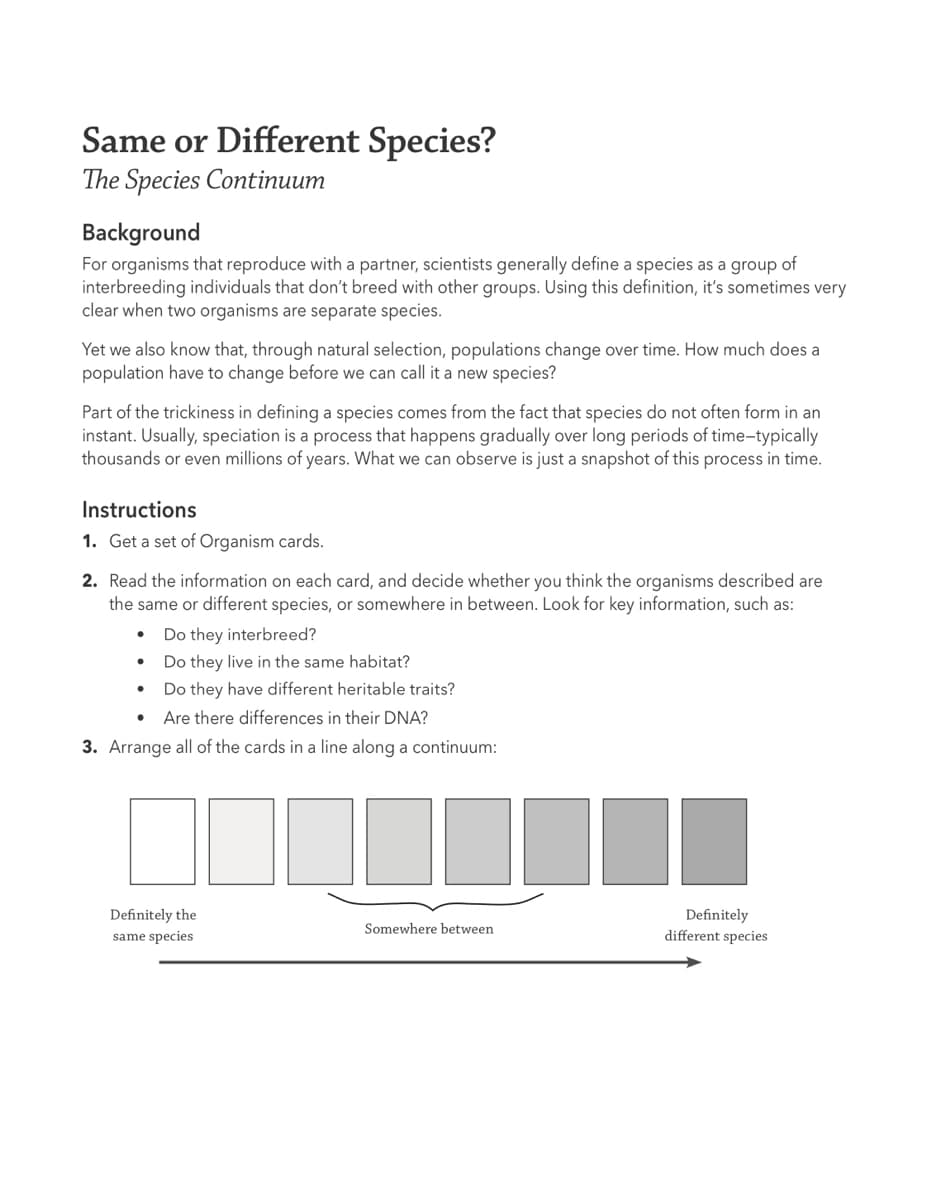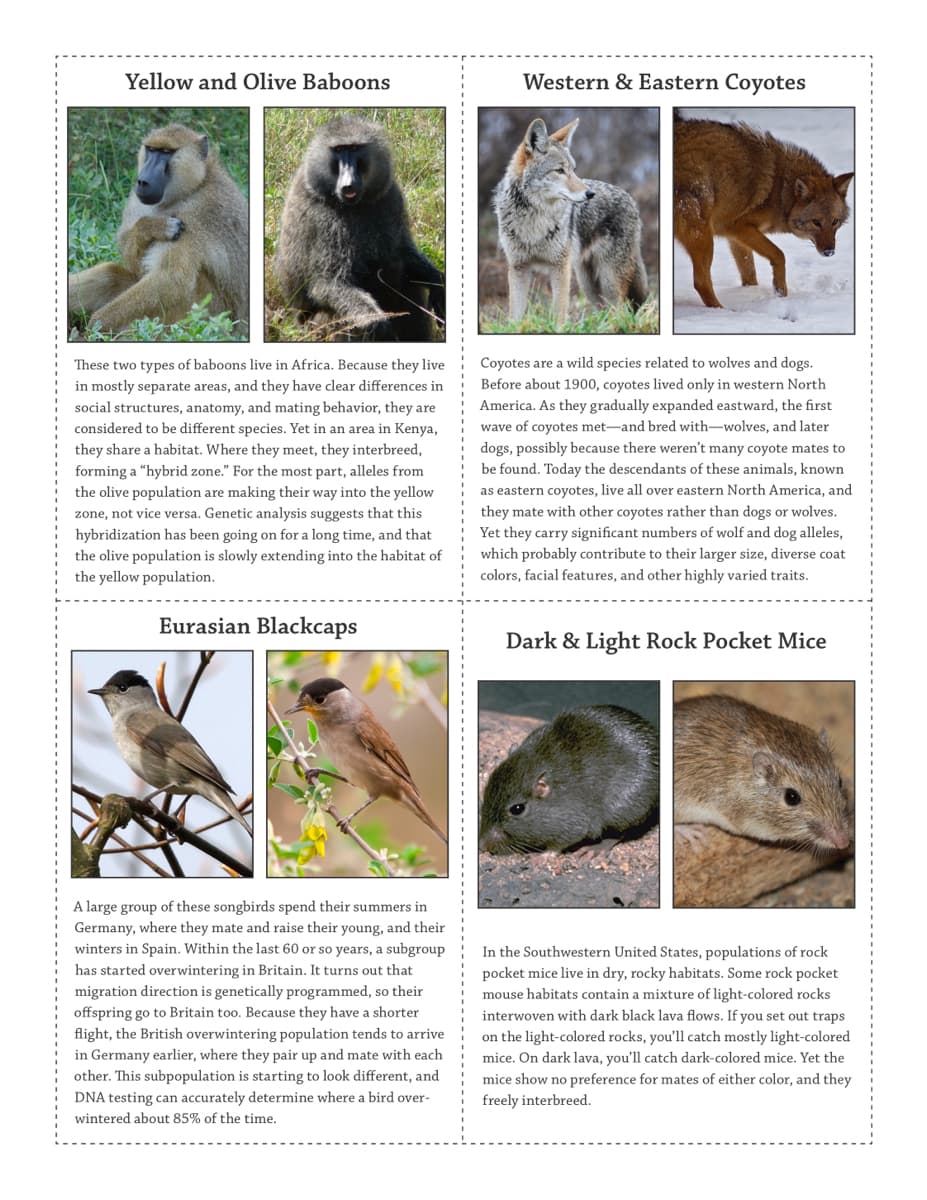Biology: The Unity and Diversity of Life (MindTap Course List)
14th Edition
ISBN:9781305073951
Author:Cecie Starr, Ralph Taggart, Christine Evers, Lisa Starr
Publisher:Cecie Starr, Ralph Taggart, Christine Evers, Lisa Starr
Chapter43: Animal Behavior
Section: Chapter Questions
Problem 2CT
Related questions
Question
What evidence led to these decisions? There should be at least one line per pair

Transcribed Image Text:Same or Different Species?
The Species Continuum
Background
For organisms that reproduce with a partner, scientists generally define a species as a group of
interbreeding individuals that don't breed with other groups. Using this definition, it's sometimes very
clear when two organisms are separate species.
Yet we also know that, through natural selection, populations change over time. How much does a
population have to change before we can call it a new species?
Part of the trickiness in defining a species comes from the fact that species do not often form in an
instant. Usually, speciation is a process that happens gradually over long periods of time-typically
thousands or even millions of years. What we can observe is just a snapshot of this process in time.
Instructions
1. Get a set of Organism cards.
2. Read the information on each card, and decide whether you think the organisms described are
the same or different species, or somewhere in between. Look for key information, such as:
Do they interbreed?
Do they live in the same habitat?
Do they have different heritable traits?
Are there differences in their DNA?
3. Arrange all of the cards in a line along a continuum:
Definitely the
Definitely
different species
Somewhere between
same species

Transcribed Image Text:Yellow and Olive Baboons
Western & Eastern Coyotes
Coyotes are a wild species related to wolves and dogs.
Before about 1900, coyotes lived only in western North
America. As they gradually expanded eastward, the first
These two types of baboons live in Africa. Because they live
in mostly separate areas, and they have clear differences in
social structures, anatomy, and mating behavior, they are
considered to be different species. Yet in an area in Kenya,
they share a habitat. Where they meet, they interbreed,
forming a "hybrid zone." For the most part, alleles from
the olive population are making their way into the yellow
zone, not vice versa. Genetic analysis suggests that this
wave of coyotes met-and bred with-wolves, and later
dogs, possibly because there weren't many coyote mates to
be found. Today the descendants of these animals, known
as eastern coyotes, live all over eastern North America, and
they mate with other coyotes rather than dogs or wolves.
Yet they carry significant numbers of wolf and dog alleles,
hybridization has been going on for a long time, and that
the olive population is slowly extending into the habitat of
the yellow population.
which probably contribute to their larger size, diverse coat
colors, facial features, and other highly varied traits.
Eurasian Blackcaps
Dark & Light Rock Pocket Mice
A large group of these songbirds spend their summers in
Germany, where they mate and raise their young, and their
winters in Spain. Within the last 60 or so years, a subgroup
In the Southwestern United States, populations of rock
has started overwintering in Britain. It turns out that
migration direction is genetically programmed, so their
offspring go to Britain too. Because they have a shorter
pocket mice live in dry, rocky habitats. Some rock pocket
mouse habitats contain a mixture of light-colored rocks
flight, the British overwintering population tends to arrive
in Germany earlier, where they pair up and mate with each
other. This subpopulation is starting to look different, and
interwoven with dark black lava flows. If you set out traps
on the light-colored rocks, you'll catch mostly light-colored
mice. On dark lava, you'll catch dark-colored mice. Yet the
mice show no preference for mates of either color, and they
freely interbreed.
DNA testing can accurately determine where a bird over-
wintered about 85% of the time.
Expert Solution
This question has been solved!
Explore an expertly crafted, step-by-step solution for a thorough understanding of key concepts.
This is a popular solution!
Trending now
This is a popular solution!
Step by step
Solved in 2 steps

Knowledge Booster
Learn more about
Need a deep-dive on the concept behind this application? Look no further. Learn more about this topic, biology and related others by exploring similar questions and additional content below.Recommended textbooks for you

Biology: The Unity and Diversity of Life (MindTap…
Biology
ISBN:
9781305073951
Author:
Cecie Starr, Ralph Taggart, Christine Evers, Lisa Starr
Publisher:
Cengage Learning

Biology: The Unity and Diversity of Life (MindTap…
Biology
ISBN:
9781337408332
Author:
Cecie Starr, Ralph Taggart, Christine Evers, Lisa Starr
Publisher:
Cengage Learning

Human Heredity: Principles and Issues (MindTap Co…
Biology
ISBN:
9781305251052
Author:
Michael Cummings
Publisher:
Cengage Learning

Biology: The Unity and Diversity of Life (MindTap…
Biology
ISBN:
9781305073951
Author:
Cecie Starr, Ralph Taggart, Christine Evers, Lisa Starr
Publisher:
Cengage Learning

Biology: The Unity and Diversity of Life (MindTap…
Biology
ISBN:
9781337408332
Author:
Cecie Starr, Ralph Taggart, Christine Evers, Lisa Starr
Publisher:
Cengage Learning

Human Heredity: Principles and Issues (MindTap Co…
Biology
ISBN:
9781305251052
Author:
Michael Cummings
Publisher:
Cengage Learning

Biology Today and Tomorrow without Physiology (Mi…
Biology
ISBN:
9781305117396
Author:
Cecie Starr, Christine Evers, Lisa Starr
Publisher:
Cengage Learning